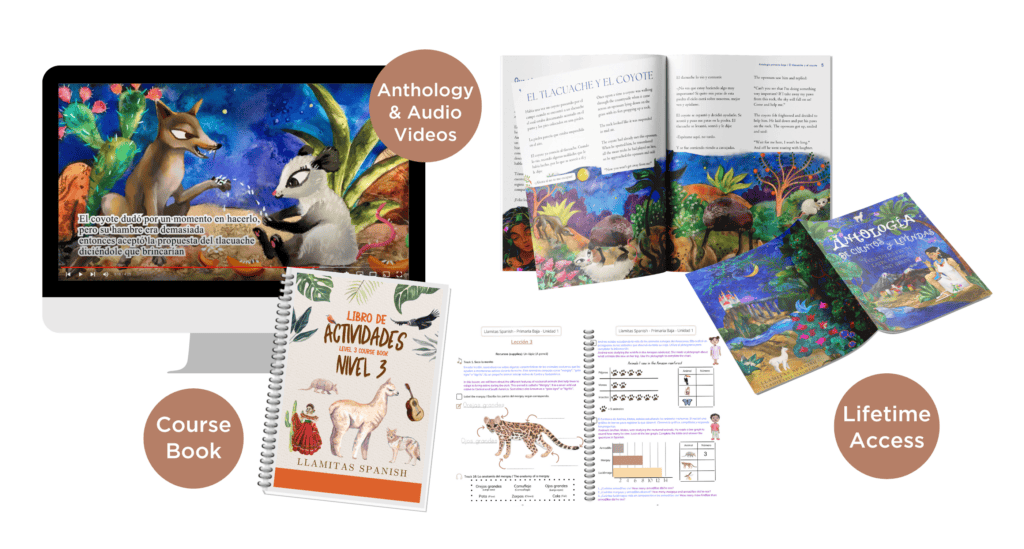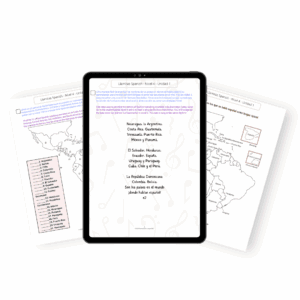In this post: Discover where Spanish is spoken around the world with this complete list of Spanish-speaking countries.
It may come as no surprise to you that Spanish is one of the most commonly spoken languages in the world—and the number of Spanish speakers worldwide continues to grow!
Maybe you’re interested in traveling to a Spanish-speaking country for an immersive language experience, or perhaps you’re planning a geography lesson alongside your child’s Spanish curriculum. Since language and culture are intrinsically connected, anyone learning Spanish should know which countries around the world speak Spanish.
At Llamitas Spanish, we’re passionate about sharing the best thematic Spanish resources for kids that we can. All of our units and printables come with bilingual scripts, so you can literally just open and go. No guesswork or prep work needed!

Our lessons are also rooted in Hispanic culture. We go beyond learning vocabulary and dive into music, art, geography and more to provide a truly authentic learning experience.
Table of Contents
How Many People Speak Spanish?
A 2021 report conducted by the Cervantes Institute found that Spanish was the native language of just under 493 million people worldwide. According to the Wilson Center, this means that Spanish is the second most common native language in the world, after Mandarin Chinese.
The study also found that the US has the fifth largest native Spanish-speaking population, after Mexico, Colombia, Argentina, and Spain. With over 41 million native Spanish speakers in the US, it also has the highest Spanish-speaking population in a country where Spanish is not the official language.
With so many native Spanish speakers and bilingual families in the US, it’s no wonder that we’re seeing a rise in bilingual education and dual language schools. As of 2021, there were 2,936 Spanish dual language immersion (DLI) programs in public schools across the US.
A bilingual education can serve multiple purposes depending on a family’s unique situation and needs. It may reinforce your native language and culture, provide extra support for English language learners, and/or teach a new language to English-speaking students.
The ultimate goal, though, is for students to enjoy the benefits of bilingualism in our increasingly globally connected world. When you look at the numbers, you can certainly see why investing in your child’s Spanish language education is an excellent idea!
Related post: Hispanic Heritage Biographies about Influential Latinos
21 Spanish Speaking Countries Around the World
Now that we know how many native Spanish speakers there are around the world, let’s take a look at where most Spanish speakers live. Spanish is the official language of 21 countries around the world, most of which you’ll find in North and South America.
Spanish Speaking Countries in North America (Central America & the Caribbean)
There are 10 Spanish-speaking countries in North America, which includes Central America and the Caribbean.
Fun fact: Puerto Rico is a US territory and has two official languages—Spanish and English.
| Country | Capital | Population |
| Costa Rica | San José | 5.154 million |
| Cuba | Havana | 11.26 million |
| Dominican Republic | Santo Domingo | 11.12 million |
| El Salvador | San Salvador | 6.314 million |
| Guatemala | Guatemala City | 17.11 million |
| Honduras | Tegucigalpa | 10.28 million |
| Mexico | Mexico City | 126.7 million |
| Nicaragua | Managua | 6.851 million |
| Panama | Panama City | 4.351 million |
| Puerto Rico (US Territory) | San Juan | 3.264 million |
Spanish Speaking Countries in South America
There are 9 Spanish-speaking countries in South America. Spanish explorers and conquistadors brought the Spanish language with them to Central and South America during the 16th and 17th centuries, which is why the language is so prevalent in these countries today.
Fun fact: Bolivia has two capitals—La Paz and Sucre. However, Sucre is considered the official capital, while La Paz is the seat of the legislative and executive branches of government.
| Country | Capital(s) | Population |
| Argentina | Buenos Aires | 45.81 million |
| Bolivia | La Paz, Sucre | 12.08 million |
| Chile | Santiago | 19.49 million |
| Colombia | Bogotá | 51.52 million |
| Ecuador | Quito | 17.8 million |
| Paraguay | Asunción | 6.704 million |
| Peru | Lima | 33.72 million |
| Uruguay | Montevideo | 3.426 million |
| Venezuela | Caracas | 28.2 million |
Spanish Speaking Countries in Europe
Despite Spain’s widespread influence throughout the Americas, Spanish is only the official language of one country in Europe, and that’s Spain!
There are several islands too that are Autonomous communities of Spain including ‘Las Islas Canarias’ (The Canary Islands) including Lanzarote, Tenerife, Fuerteventura, Gran Canaria, La Gomera and La Palma. As well as ‘Las Islas Baleares’ (The Balearic islands) including Minorca, Majorca and Ibiza.
Fun fact: Castilian Spanish is the official language of Spain, but there are 4 other co-official languages used in some territories—Catalan/Valencian, Galician, Basque, and Aranese.
| Country | Capital | Population |
| Spain | Madrid | 47.4 million |
Spanish Speaking Countries in Africa
The only Spanish-speaking country in Africa is Equatorial Guinea. The country was under Spanish colonial rule beginning in the late 18th century before gaining independence in 1968.
Fun fact: Equatorial Guinea has 3 official languages—Spanish, French, and Portuguese.
| Country | Capital | Population |
| Equatorial Guinea | Malabo | 1.634 million |
Related post: Hispanic Heritage Month Children’s Books
Map of Spanish Speaking Countries
Planning a geography lesson as a part of your homeschool Spanish curriculum? Check out our map of Spanish-speaking countries!
Our maps can be found in our Level 4 curriculum, unit 1: El mundo hispanohablante (The Spanish Speaking World). Students label the Spanish speaking countries, learn about nationalities, and even practice a song to memorize the official Spanish speaking countries.

Spanish Homeschool Curriculum
With Spanish being such a popular language around the world, it makes a fantastic choice for families looking to add a foreign language to their homeschooling.
If you know the benefits of bilingualism but aren’t sure where to start, our Llamitas Spanish Curriculum has everything you need to teach Spanish to your kids.

This Level 1 Spanish curriculum was designed for both bilingual families as well as those with no prior Spanish language skills. Since everything is scripted in both English and Spanish, you can literally just open and go. No planning necessary!
Not only does our curriculum make teaching Spanish easy for you, but it provides your kids with an authentic language learning experience. Thematic lessons are rooted in Hispanic culture and allow your children to apply their language skills across subjects.
Grades 2-3 are perfect for elementary students and dive into many geography and cultural topics such as exploring the Mayan Culture, the Amazon Rainforest, famous latinos, and much more!
